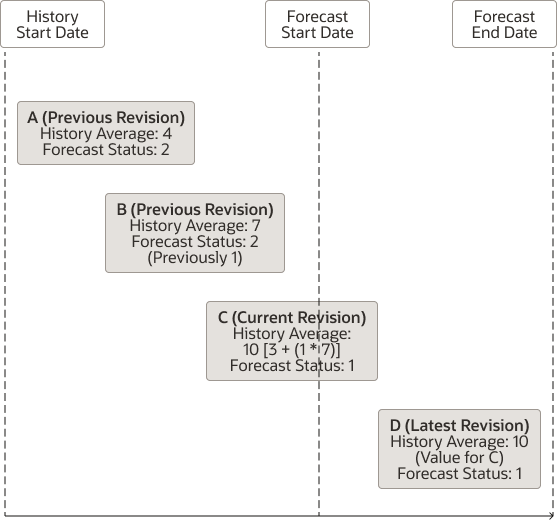How the History Average Measure Is Calculated for the Current Revision and Latest Revision
When you run your plan with the Refresh with current data option selected on the Parameters tab in the Run Plan dialog box, the history average measure is calculated for the current revision and latest (future) revision of an item.
When you run your plan while refreshing it with current data, during the calculation of proportions, a history average is calculated and forecast status set for each combination in the historical demand. The specific measures that store these values are determined by the forecasting profile for the plan.
History Average Measure
The history average measure is used for disaggregating a forecast from the level that it's generated at to the level that it's stored at. This disaggregation results in each combination getting its share of the forecast based on its share of the historical demand.
Examples of the history average measure are the predefined Bookings History Average and Shipments History Average measures.
Forecast Status Measure
The forecast status measure identifies which combinations are active and should receive forecasts. The measure values are 1 (Active), 2 (Inactive/New/Immature), and 3 (Inactive/Retired/Discontinued). Only combinations with a forecast status of 1 receive forecasts.
Examples of the forecast status measure are the predefined Bookings Forecast Status and Shipments Forecast Status measures.
Calculation of the History Average Measure for the Current Revision and Latest Revision
For the current revision, the value of the history average measure from the corresponding, active previous revision in a supersession chain or across supersession chains is taken. The final value of the measure for the current revision is calculated according to this formula:
History Average Measure = History Average Measure of the Current Revision Available up to the Plan Start Date + (Forecast Status Measure of the Previous Revision x History Average Measure of the Previous Revision)
The final value of the history average measure for the current revision is taken as the measure value for the latest revision.
When the history average measure is computed, the value of the forecast status measure is also changed for the previous revisions, current revision, and latest revision. The value of the measure is set to 1 for the current revision and latest revision irrespective of the demand history. The value of the measure is set to 2 for the previous revisions. These statuses are set because the current revision and latest revision should receive the forecast, but the superseded (previous) versions shouldn't receive a forecast.
Consider an example in which a supersession chain has previous revisions A and B, current revision C, and latest revision D:
- For A, the value of the history average measure is 4. The value of the forecast status measure is 2.
- For B, the value of the history average measure is 7. The value of the forecast status measure is 1.
- For C, the value of the history average measure available up to the plan start
date is 3. The value of the forecast status measure is 1.
Thus, the final value of the history average measure for C is 10 [3 + (1 * 7)].
- For D, the value of the history average measure is 10 (the value of the measure for C). The value of the forecast status measure is 1.
- After the final values of the history average measure for C and D are calculated, the value of the forecast status measure for B is set to 2.
The following figure depicts this example:
